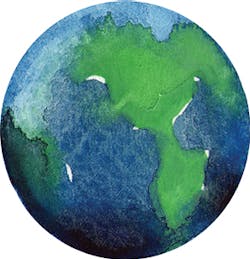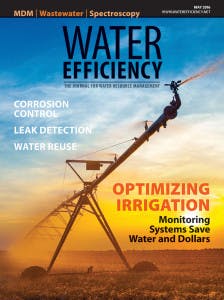It’s been said that the Apollo astronauts traveled to space to explore the moon but instead discovered the Earth. As they gazed back at the blue-green pearl of their home planet, the view offered them profound insight. Perspective granted them clarity.
Today, technology and data offer us this omniscient view. We use digital tools and the information they provide to increase our understanding of our water resources: their location, quality, and global distribution. We’re able to observe the planet’s natural systems and collect long-term records. As a result, today we’re able to manage and conserve water in smarter, more sophisticated ways. Welcome to the age of fluid intelligence.
From an altitude of 436 miles above the Earth, NASA can generate global soil moisture maps with high-resolution radar imaging, an innovation that will improve weather forecasting and provide climatological insight. Scientists can also evaluate water quality from the air with a spectrometer that detects the spectral signature of water’s primary components and contaminants. This tool, called a PRISM spectrometer, will eventually provide continuous global monitoring and water quality data from a satellite. Trained computers can now analyze USGS maps and, pixel by pixel, determine where water is located on the planet as the effects of climate change transform our landscape. Technological advances and machine learning are helping hydrologists map and model the future.
We also receive big-picture insight from data collected on the ground. Complex sensors and smart meters in our cities, homes, offices, and agricultural fields collect information about our water usage, detailing the outflow, pressure, water quality, and time of use. Computer software and control panels translatethe data into actionable information. And the patterns that emerge when numbers are interpreted offer us empirical insight, allowing us to make evidence-based decisions. This universal perspective helps us utilize water with increased precision and efficiency.
In this issue, we discuss some of the innovative technologies that promote resourceful water usage and conservation. We explore cutting-edge irrigation technologies like soil moisture sensors, fertilizer injectors, and electrical conductivity detectors in “Optimizing Irrigation” that help growers maximize nutrient uptake, reduce water expenses, and increase crop yield.
In “Knowledge is Power”, we see how real-time data collected from geolocated smart meters helps utilities locate non-revenue water loss, understand usage patterns, and heighten customer awareness. In “Fully Rinsed? Spectroscopy Provides Answers”, we look at ways in which tools like in-line spectroscopes facilitate water conservation with concrete data, by offering facilities managers assurance that a pipeline is clean and eliminating the need for excessive flushing.
The implications of these technologies are both powerful and potentially life-saving. More than 1 billion people lack access to clean water on our planet today, a staggering number considering that 3.9 trillion gallons of water are consumed in the United States each month. Water’s scarcity and irregular distribution is a global crisis that makes it imperative for water consumers and policymakers to streamline our usage, wisely reuse resources, and optimize our water efficiency.
Technology supports this awareness. With the help of digital tools and the fluid intelligence they provide, we’re able to observe our water matrix, question our current consumption patterns, and determine actionable, long-term solutions to many of our hydrologic concerns. Data, like distance, offers us theclarity and insight we need to take enlightened steps forward.
How does it guide your water conservation efforts?To access additional case studies and in-depth reporting, check out the May edition of Water Efficiency.
You may need to log-in or subscribe to our magazine.


